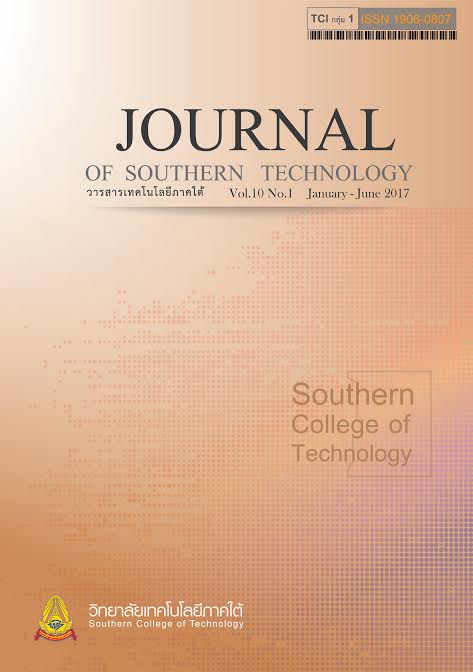การเปรียบเทียบการจัดการขยะมูลฝอยขององค์การบริหารส่วนตําบล ในอําเภอเมืองปัตตานี จังหวัดปัตตานี
Main Article Content
Abstract
การเปรียบเทียบการจัดการขยะมูลฝอยขององค์การบริหารส่วนตําบล ในอําเภอเมืองปัตตานี จังหวัดปัตตานี
การวิจัยครั้งนี้มีวัตถุประสงค์เพื่อ (1) ศึกษาสภาพปัญหาในการดําเนินการจัดการขยะมูลฝอยขององค์การบริหารส่วน ตําบล (อบต.) ในอําเภอเมืองปัตตานี จังหวัดปัตตานี และ (2) เปรียบเทียบการจัดการขยะมูลฝอยของอบต. ในอําเภอเมือง ปัตตานี จังหวัดปัตตานี โดยการรวบรวมข้อมูลจากประชาชนตําบลบานาและตําบลตะลุโบะ อําเภอเมืองปัตตานี จังหวัด ปัตตานี จํานวน 400 คน และ ผู้บริหารอบต. จํานวน 14 คน วิเคราะห์ข้อมูลใช้สถิติ ค่าเฉลี่ย ค่าเบี่ยงเบนมาตรฐาน ทดสอบค่า t-test และการวิเคราะห์เนื้อหา จากการศึกษาพบว่า ปัญหาในการดําเนินการจัดการขยะมูลฝอยของอบต.ในอําเภอเมืองปัตตานี จังหวัดปัตตานี คือ ด้านการมีจิตสํานึกในการจัดการขยะมูลฝอย (=3.78, S.D. =1.49) ด้านการกําจัดขยะมูลฝอย (
=3.51, S.D. =1.16) ด้านการเก็บรวบรวมขยะ (
=3.47, S.D. =0.87) ด้านการพัฒนาการบริหารจัดการขยะมูลฝอย (
=3.44, S.D. =1.34) และ ด้านการขนย้ายขยะมูลฝอย (
=3.19, S.D. =1.17) ปัญหา คือ รถที่ใช้ในการขนย้ายมีจํานวนไม่เพียงพอต่อความต้องการของ ประชาชน ข้อเสนอแนะ ควรจัดกิจกรรมรณรงค์คัดแยกขยะมูลฝอย ณ แหล่งกําเนิด เพื่อลดปริมาณขยะมูลฝอยที่ต้องนําไป กําจัด บูรณาการร่วมในการลดปริมาณขยะทั้งภาครัฐและภาคเอกชน และสร้างนวัตกรรมใหม่ ๆ ให้ประชาชนจัดการขยะใน ครัวเรือน ผลการประเมินความรู้การจัดการขยะมูลฝอย พบว่า กลุ่มตัวอย่างมีความรู้การจัดการขยะมูลฝอยอยู่ในระดับดี และ ผลการทดสอบวัดระดับความรู้ก่อนและหลังการอบรม พบว่า มีความแตกต่างกันอย่างมีนัยสําคัญทางสถิติที่ระดับ .01 และ เปรียบเทียบการจัดการขยะมูลฝอยของอบต.ในอําเภอเมืองปัตตานี ระหว่างอบต.บานา กับ อบต.ตะลุโบะ พบว่า ทั้งสองตําบล ได้มีการจัดการขยะมูลฝอยที่มีลักษณะคล้าย ๆ กัน จะแตกต่างเฉพาะสถานที่กําจัดขยะมูลฝอย อบต.บานา จะเข้ารับบริการ กําจัดขยะแบบฝังกลบของเทศบาลเมืองปัตตานี แต่อบต.ตะลุโบะดําเนินการจ้างเอกชนฝังกลบขยะมูลฝอยในพื้นที่ของตนเอง เนื่องจากมีข้อจํากัดด้านงบประมาณ
The Comparison of Solid Waste Management of Sub-district Administrative Organizations in Mueang Pattani District Pattani Province
This present research aimed to (1) study factors of Solid Waste Management of Sub-district Administrative Organizations in Mueang Pattani District Pattani, Province and (2) compare its solid waste management by collecting the questionnaires from 400 persons and 14 Sub-district administrative officers in Bana Sub-district and Taluboh Sub-district in Mueang Pattani Disctirct, Pattani Province. The results showed that factors affected Solid Waste management of sub-district administrative organizations in Mueang Pattani District Pattani Province were people’ conscious minds toward Solid Waste Management (=3.78, S.D. =1.49), Solid Waste Management (
=3.51, S.D. =1.16), Solid Waste Collecting (
=3.47, S.D. =0.87), Development of Solid Waste Management (
=3.44, S.D. =1.34), and Solid Waste Transporting (
=3.19, S.D. =1.17). The main problem was insufficient amount of solid waste vehicles. The suggestions were promoting the campaign for sorting out solid waste in order to decrease the amount of the solid waste, cooperating between governmental and private organization and inventing the innovation for people to manage the solid waste by their own. The results also showed that the participants had understood about solid waste management at good level. The difference between pre-test and post-test scores after the training project was statistically significant at .01 level. The comparison between solid waste management of administrative organizations in Bana Sub-district and Taluboh Sub-district was quite similar the same but different at the place of eliminating the solid waste. Solid waste management of administrative organizations in Bana sub-district depended on Mueang Pattani Sub-district administrative organizations. In contrast, Taluboh Sub-district hired the private organization to manage the solid waste. This was because of its lack of budget.
Article Details
-
Authors must agree to the journal publication rules and allow the editors to edit the manuscripts for publication.
-
Author’s right belongs to the author but Journal of Southern Technology holds the right of first publication and thus allow readers to use the article for the purpose of education but not commercial.

